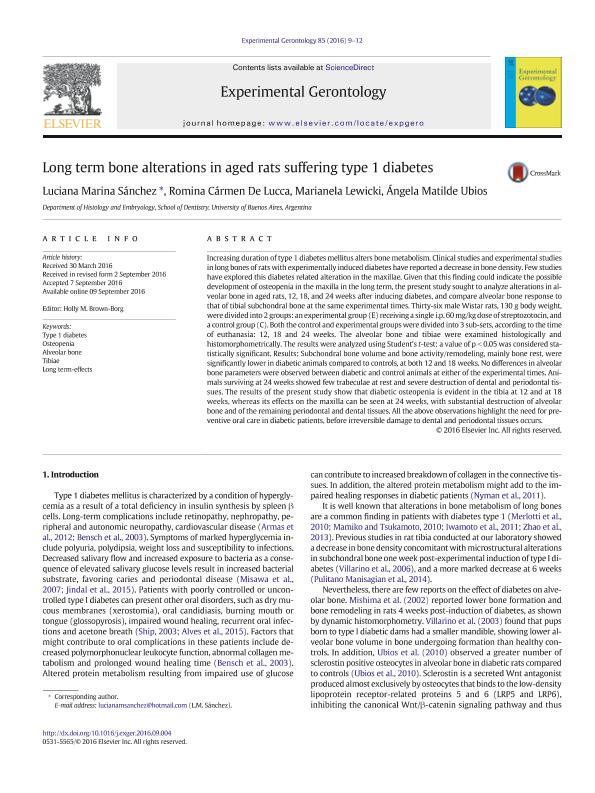Mostrar el registro sencillo del ítem
dc.contributor.author
Sánchez, Luciana Marina

dc.contributor.author
de Lucca, Romina Carmen

dc.contributor.author
Lewicki, Marianela

dc.contributor.author
Ubios, Angela Matilde

dc.date.available
2018-06-06T19:11:28Z
dc.date.issued
2016-12
dc.identifier.citation
Sánchez, Luciana Marina; de Lucca, Romina Carmen; Lewicki, Marianela; Ubios, Angela Matilde; Long term bone alterations in aged rats suffering type 1 diabetes; Pergamon-Elsevier Science Ltd; Experimental Gerontology; 85; 12-2016; 9-12
dc.identifier.issn
0531-5565
dc.identifier.uri
http://hdl.handle.net/11336/47536
dc.description.abstract
Increasing duration of type 1 diabetes mellitus alters bone metabolism. Clinical studies and experimental studies in long bones of rats with experimentally induced diabetes have reported a decrease in bone density. Few studies have explored this diabetes related alteration in the maxillae. Given that this finding could indicate the possible development of osteopenia in the maxilla in the long term, the present study sought to analyze alterations in alveolar bone in aged rats, 12, 18, and 24 weeks after inducing diabetes, and compare alveolar bone response to that of tibial subchondral bone at the same experimental times. Thirty-six male Wistar rats, 130 g body weight, were divided into 2 groups: an experimental group (E) receiving a single i.p. 60 mg/kg dose of streptozotocin, and a control group (C). Both the control and experimental groups were divided into 3 sub-sets, according to the time of euthanasia: 12, 18 and 24 weeks. The alveolar bone and tibiae were examined histologically and histomorphometrically. The results were analyzed using Student's t-test; a value of p < 0.05 was considered statistically significant. Results: Subchondral bone volume and bone activity/remodeling, mainly bone rest, were significantly lower in diabetic animals compared to controls, at both 12 and 18 weeks. No differences in alveolar bone parameters were observed between diabetic and control animals at either of the experimental times. Animals surviving at 24 weeks showed few trabeculae at rest and severe destruction of dental and periodontal tissues. The results of the present study show that diabetic osteopenia is evident in the tibia at 12 and at 18 weeks, whereas its effects on the maxilla can be seen at 24 weeks, with substantial destruction of alveolar bone and of the remaining periodontal and dental tissues. All the above observations highlight the need for preventive oral care in diabetic patients, before irreversible damage to dental and periodontal tissues occurs.
dc.format
application/pdf
dc.language.iso
eng
dc.publisher
Pergamon-Elsevier Science Ltd

dc.rights
info:eu-repo/semantics/openAccess
dc.rights.uri
https://creativecommons.org/licenses/by-nc-nd/2.5/ar/
dc.subject
Type 1 Diabetes
dc.subject
Osteopenia
dc.subject
Alveolar Bone
dc.subject
Long Term Effects
dc.subject.classification
Otras Medicina Básica

dc.subject.classification
Medicina Básica

dc.subject.classification
CIENCIAS MÉDICAS Y DE LA SALUD

dc.title
Long term bone alterations in aged rats suffering type 1 diabetes
dc.type
info:eu-repo/semantics/article
dc.type
info:ar-repo/semantics/artículo
dc.type
info:eu-repo/semantics/publishedVersion
dc.date.updated
2018-06-06T13:39:33Z
dc.journal.volume
85
dc.journal.pagination
9-12
dc.journal.pais
Estados Unidos

dc.description.fil
Fil: Sánchez, Luciana Marina. Universidad de Buenos Aires. Facultad de Odontología; Argentina
dc.description.fil
Fil: de Lucca, Romina Carmen. Universidad de Buenos Aires. Facultad de Odontología; Argentina
dc.description.fil
Fil: Lewicki, Marianela. Universidad de Buenos Aires. Facultad de Odontología; Argentina. Consejo Nacional de Investigaciones Científicas y Técnicas; Argentina
dc.description.fil
Fil: Ubios, Angela Matilde. Universidad de Buenos Aires. Facultad de Odontología; Argentina. Consejo Nacional de Investigaciones Científicas y Técnicas; Argentina
dc.journal.title
Experimental Gerontology

dc.relation.alternativeid
info:eu-repo/semantics/altIdentifier/doi/http://dx.doi.org/10.1016/j.exger.2016.09.004
dc.relation.alternativeid
info:eu-repo/semantics/altIdentifier/url/https://www.sciencedirect.com/science/article/pii/S0531556516303254
Archivos asociados
